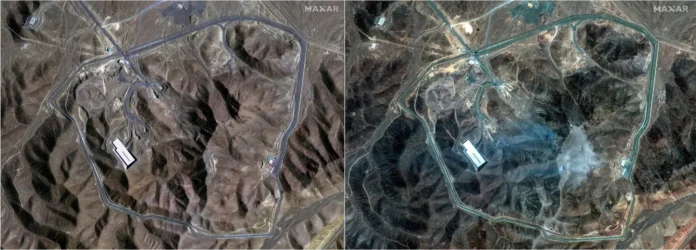Washington, D.C., June 25, 2025 — The White House has firmly rejected recent media reports suggesting that US-led airstrikes on Iranian nuclear facilities only marginally delayed Tehran’s nuclear weapons development.
The denial comes in response to investigative pieces published by CNN and The New York Times, both citing a preliminary classified assessment by the Defense Intelligence Agency (DIA). According to the reports, the US bombing campaign succeeded in blocking access to key facilities but failed to destroy Iran’s underground nuclear infrastructure, leaving its program largely intact.
Media Reports: “Strikes Delayed Iran’s Program by Months”
Both CNN and The New York Times reported on Tuesday that according to early DIA intelligence, the US airstrikes sealed entrances to at least two nuclear sites, but did not penetrate the deeply-buried sections, such as those at Fordow and Natanz.
The assessment allegedly concludes that Iran’s nuclear progress has been delayed by less than six months, contradicting President Donald Trump’s assertion last week that the strikes “obliterated” Iran’s nuclear infrastructure.
Before the air campaign, US intelligence agencies had estimated that Iran could potentially produce a basic nuclear device in approximately three months if it chose to expedite enrichment, as reported by the International Atomic Energy Agency (IAEA) and reflected in Congressional briefings.
White House Fires Back: “Flat-Out Wrong”
White House spokesperson Karoline Leavitt dismissed the DIA’s alleged findings and criticized the media’s coverage of the leak.
“This alleged ‘assessment’ is flat-out wrong,” Leavitt told reporters.
“It was classified as ‘top secret’ but was still leaked to CNN by an anonymous, low-level loser in the intelligence community.”
She characterized the leak as an attempt to undermine President Trump and discredit the fighter pilots who executed the mission, stating:
“Everyone knows what happens when you drop fourteen 30,000-pound bombs perfectly on their targets: total obliteration.”
The GBU-57 Massive Ordnance Penetrator (MOP) bombs, referenced in this statement, are designed to strike fortified underground targets. According to the US Air Force, each weighs approximately 30,000 pounds and is capable of penetrating up to 60 meters of reinforced concrete.
Iran Allegedly Moved Uranium Stockpile Before Strikes
Officials cited by The New York Times claimed that Iran had preemptively relocated a portion of its enriched uranium stockpile to other facilities, blunting the effectiveness of the US strikes.
Some of this material is believed to have been moved to undisclosed locations, making it harder to assess whether the air campaign truly crippled Iran’s nuclear ambitions.
The Fordow Fuel Enrichment Plant, built deep within a mountain near Qom, was reportedly targeted and suffered damage to its electrical systems, but the timeline for repairs remains uncertain, according to anonymous officials familiar with the operation.
Congressional Briefing on DIA Report Delayed
A classified briefing scheduled for Congress on Tuesday to review the DIA’s preliminary findings was postponed, with lawmakers now expected to be updated on Thursday, per a report from Politico.
US Military: Iran Still a Tactical Threat
Despite the strategic damage inflicted by the US and Israeli strikes, Iran retains “considerable tactical capability”, according to Navy Vice Admiral Charles “Chas” Cooper II, the nominee to lead US Central Command (CENTCOM).
“They possess considerable tactical capability, one element of which we saw yesterday,” Cooper told the Senate Armed Services Committee during his confirmation hearing, referencing Iran’s retaliatory missile strike on Al Udeid Air Base in Qatar.
The CENTCOM nominee warned that Iran still poses a credible threat to US personnel and bases in the region, emphasizing that further military readiness is necessary despite the damage done to Iran’s broader infrastructure.
Ongoing Uncertainty as Intelligence Evaluations Continue
US officials stress that the current intelligence assessments remain preliminary, and that further evaluations are expected in the coming weeks. As of now, the true extent of the damage to Iran’s nuclear program remains unclear, especially with speculation surrounding underground uranium processing facilities and secret stockpiles.
The IAEA has not yet released an updated report on Iran’s nuclear enrichment capabilities post-strike, and UN inspectors have not been granted access to verify the scope of destruction.










